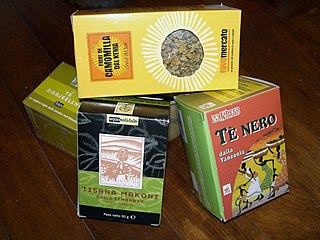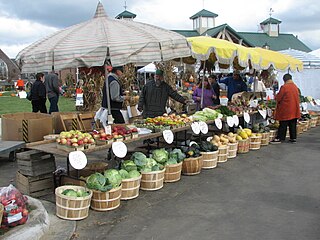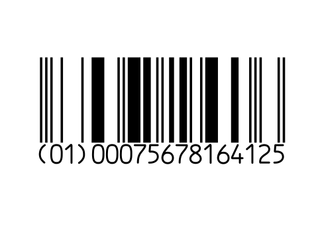
Fair trade is an arrangement designed to help producers in growing countries achieve sustainable and equitable trade relationships. The fair trade movement combines the payment of higher prices to exporters with improved social and environmental standards. The movement focuses in particular on commodities, or products that are typically exported from developing countries to developed countries, but is also used in domestic markets, most notably for handicrafts, coffee, cocoa, wine, sugar, fruit, flowers, and gold.

The Universal Product Code is a barcode symbology that is widely used worldwide for tracking trade items in stores.

A barcode or bar code is a method of representing data in a visual, machine-readable form. Initially, barcodes represented data by varying the widths, spacings and sizes of parallel lines. These barcodes, now commonly referred to as linear or one-dimensional (1D), can be scanned by special optical scanners, called barcode readers, of which there are several types. Later, two-dimensional (2D) variants were developed, using rectangles, dots, hexagons and other patterns, called matrix codes or 2D barcodes, although they do not use bars as such. 2D barcodes can be read using purpose-built 2D optical scanners, which exist in a few different forms. 2D barcodes can also be read by a digital camera connected to a microcomputer running software that takes a photographic image of the barcode and analyzes the image to deconstruct and decode the 2D barcode. A mobile device with an inbuilt camera, such as smartphone, can function as the latter type of 2D barcode reader using specialized application software.
Sales promotion is one of the elements of the promotional mix. The primary elements in the promotional mix are advertising, personal selling, direct marketing and publicity/public relations. Sales promotion uses both media and non-media marketing communications for a pre-determined, limited time to increase consumer demand, stimulate market demand or improve product availability. Examples include contests, coupons, freebies, loss leaders, point of purchase displays, premiums, prizes, product samples, and rebates.

A farmers' market is a physical retail marketplace intended to sell foods directly by farmers to consumers. Farmers' markets may be indoors or outdoors and typically consist of booths, tables or stands where farmers sell their produce, live animals and plants, and sometimes prepared foods and beverages. Farmers' markets exist in many countries worldwide and reflect the local culture and economy. The size of the market may be just a few stalls or it may be as large as several city blocks. Due to their nature, they tend to be less rigidly regulated than retail produce shops.

Price look-up codes, commonly called PLU codes, PLU numbers, PLUs, produce codes, or produce labels, are a system of numbers that uniquely identify bulk produce sold in grocery stores and supermarkets. The codes have been in use since 1990, and over 1400 have been assigned. The codes are administered by the International Federation for Produce Standards (IFPS), a global coalition of fruit and vegetable associations that was formed in 2001 to introduce PLU numbers globally.
The Global Trade Item Number (GTIN) is an identifier for trade items, developed by the international organization GS1. Such identifiers are used to look up product information in a database which may belong to a retailer, manufacturer, collector, researcher, or other entity. The uniqueness and universality of the identifier is useful in establishing which product in one database corresponds to which product in another database, especially across organizational boundaries.

GS1 is a private, not-for-profit, international organization developing and maintaining its own standards for barcodes and the corresponding issue company prefixes. The best known of these standards is the barcode, a symbol printed on products that can be scanned electronically.

The International Article Number is a standard describing a barcode symbology and numbering system used in global trade to identify a specific retail product type, in a specific packaging configuration, from a specific manufacturer. The standard has been subsumed in the Global Trade Item Number standard from the GS1 organization; the same numbers can be referred to as GTINs and can be encoded in other barcode symbologies defined by GS1. EAN barcodes are used worldwide for lookup at retail point of sale, but can also be used as numbers for other purposes such as wholesale ordering or accounting. These barcodes only represent the digits 0–9, unlike some other barcode symbologies which can represent additional characters.
In the distribution and logistics of many types of products, track and trace or tracking and tracing concerns a process of determining the current and past locations of a unique item or property.

GS1 DataBar is a family of symbols most commonly seen in the GS1 DataBar Coupon. The symbology is formally defined as ISO/IEC 24724:2006. The name was changed from RSS to GS1 DataBar due to the potential for confusion with Really Simple Syndication.

An EAN-8 is an EAN/UPC symbology barcode and is derived from the longer International Article Number (EAN-13) code. It was introduced for use on small packages where an EAN-13 barcode would be too large; for example on cigarettes, pencils, and chewing gum packets. It is encoded identically to the 12 digits of the UPC-A barcode, except that it has 4 digits in each of the left and right halves.
Counterfeit consumer goods are goods, often of inferior quality, made or sold under another's brand name without the brand owner's authorization. Sellers of such goods may infringe on either the trademark, patent or copyright of the brand owner by passing off its goods as made by the brand owner. Counterfeit products made up 5 to 7% of world trade in 2013, and in 2014 cost an estimated 2.5 million jobs worldwide, with up to 750,000 jobs lost in the U.S. About 5% of goods imported into the European Union in 2013 were fakes, according to the OECD.
Produce traceability makes it possible to track produce from its point of origin to a retail location where it is purchased by consumers.

The GS1 Databar Coupon code has been in use in retail industry since the mid-1980s. At first, it was a UPC with system ID 5. Since UPCs cannot hold more than 12 digits, it required another bar code to hold additional information like offer code, expiration date and household ID numbers. Therefore, the code was often extended with an additional UCC/EAN 128 bar code. EAN 13 was sometimes used instead of UPC, and because it starts with 99, it was called the EAN 99 coupon barcode, and subsequently GS1 DataBar. After more than 20 years in use, there is now a need to encode more data for complex coupons, and to accommodate longer company IDs, so the traditional coupon code has become less efficient and sometimes not usable at all.
Healthy Grown Potato is an eco-brand that provides high-quality, sustainably grown, packaged, and shipped potatoes to consumers by leveraging integrated pest management (IPM) farming practices on large scale farms. A certification process is mandatory to market products as Healthy Grown. Through this program, growers implement on-farm conservation to improve biodiversity and restore native ecosystems on unfarmed parcels of land. All implemented practices are research-based by the University of Wisconsin-Madison and are found to be economically viable and ecologically sound and are supported by various non-governmental organizations. This whole-farm approach takes into consideration practices that consider water quality and soil erosion and has led to a reduced use of nutrients and pesticides. The goals of the Healthy Grown program as set forth in the approved Memorandum of Understanding include:
Farm gate marketing or farmgate sales describes a direct marketing method whereby farmers sell agricultural produce—mostly food—directly to the consumer, to restaurants and caterers, and to independent retailers. Farm gate sales are a common type of marketing found throughout traditional small farming sectors worldwide and, in some countries, account for the vast amount of sales as far as foodstuffs and livestock are concerned.
In the United Kingdom, it is common practice for retailers to have their own value brand in an effort to compete on price. These brands have become more popular in the UK with shoppers since the Great Recession caused food prices to rise.
Slow Flowers is a movement promoting the support and purchase of American-grown flowers in the United States. Similar to the Slow Food movement—aimed at preserving local, sustainable food and traditional cooking—Slow Flowers encourages consumers to support their local economy and consciously purchase cut flowers grown locally, seasonally and ethically in the United States, instead of purchasing flowers imported from other countries or flowers grown using chemicals and pesticides. The philosophy behind slow flowers is part of the wider slow movement. The Slow Flowers Community was founded by author and writer Debra Prinzing in 2014 after she authored a book titled Slow Flowers, in which the term "slow flowers movement" was coined, and the movement has since spread internationally.
Frieda Rapoport Caplan was an American businesswoman who was the founder of Frieda's Inc., a specialty produce company in Los Alamitos, California. She created the specialty produce industry in the United States and revolutionized the fresh produce industry.








